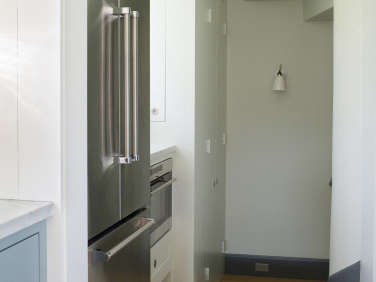A full kitchen remodel may not be on your immediate to-do list. But simply swapping in a new appliance (especially if the old one isn’t performing well) is an easy way to upgrade your space. In our new miniseries on what to know when replacing your appliances, we’ll be answering questions you may have about doing that. We’ll start with the fridge, the bulkiest, most prominent appliance in the kitchen.
To get some answers to common FAQs, we talked with Andrea Zaff of Boston-based Zaff Architecture. Among other things, Andrea specializes in helping her clients source appliances, so she has plenty of expertise to share. Her key piece of advice: Measure, measure, measure. Not just so you’ll be able to fit the new fridge in your kitchen, but to be sure you can get it in the door.
Here are eight questions to ask when swapping out your existing fridge for a new one.

I’m getting a new fridge. Will I need to upgrade the wiring?
Probably not. Your existing fridge should already be powered by a dedicated 20-amp, 120-volt circuit, with no other electrical load on the circuit. In a house or apartment, a refrigerator located in the kitchen doesn’t require a ground fault circuit interrupter (GFCI). So even if you’re upgrading to a huge Sub-Zero, there shouldn’t be any need to change the wiring. (But ask an electrician if you have any concerns.)
How do I know if my new fridge will fit in the existing space?
“Height, depth, and width are all critical measurements,” Andrea says. “You usually need a gap of about two inches between the side of the fridge and the cabinets to allow the hinge to operate fully—the doors need to open 90 degrees or more to give you full access to the pullout bins.” If you don’t have a two-inch gap on the hinge side, your refrigerator may need to be pulled out two inches to make up for this. (More on leaving room for door swing below.) Also, says Andrea, refrigerators need room to breathe. Most manufacturers specify one inch of ventilation space at the top and back of the unit. The exact requirements are noted on the spec sheet.
Start by measuring the existing fridge, and ask yourself “Is this fridge big enough for my household?” Note that freestanding fridges vary not just in height and width, but also in depth: Standard depth ranges from 30 to 34 inches; counter depth, in which the front of the fridge is flush with the cabinetry, is 23 to 30 inches. Counter-depth refrigerators offer a streamlined look that gives you a clean overall aesthetic.

Can I get more fridge space without making major changes to my kitchen?
Depending on the ceiling height, you might be able to upgrade to a bigger fridge that’s the same width as your old one, but taller. You can change a standard-depth fridge to a counter-depth unit without remodeling your entire kitchen, because they’re manufactured in standard sizes (though these can vary by manufacturer) and will most likely fit in your existing opening. This gives your kitchen a unified look without the expense of using built-in appliances.
Counter-depth refrigerators are shallower, which makes it easier to access the contents. When choosing, take precise measurements of your existing opening and check the various models’ specification sheets. These refrigerators are more expensive than standard-depth models, but less expensive than a built-in fridge (which requires specific cutouts and cabinets to be built around it).
If you need more fridge space than what the current space allows, consider adding not a bigger model, but an additional one. Andrea Zaff made more fridge space in her own home by installing a second, smaller refrigerator/freezer under the counter. “That’s the fridge we use most often. We keep things like milk, sparkling water, and yogurt there, and it gives the kids easy access to beverages.” Most under-counter refrigerator/freezers and wine coolers are 24 inches deep, so they’re flush with the cabinetry.

How does the door configuration matter when it comes to fitting a new fridge into my kitchen?
While a single-door fridge is the most economical model, the door swing requires a fair amount of clearance. Measure your floor space to make sure you have enough room, including that two-inch gap on the hinge side. (Note that single-doors, while cheaper, are less energy-efficient.)
Half-width door options are either French doors—two narrow doors that open out and away from each another, plus a freezer on bottom—or side-by-side doors—two narrow, full-length doors, with the section on the right typically used for cold storage and the section on the left for the freezer.
These doors are much shallower when they’re open, saving about six inches of floor space. But the fridges are typically wider overall, requiring a larger space.
Whether you decide on one door or two, the freezer location is something else to consider. The options are: freezer on the top, freezer on the bottom, and freezer on the side (usually the left). Or, if you have the space, you might consider combining an all-refrigerator unit with a stand-alone freezer. Which one will work best in your home?
Andrea offers this tip: “For shorter people like me, having the freezer on the bottom isn’t a great choice, since it makes the top shelf of the fridge hard to reach!”

What if my new, larger fridge doesn’t fit?
A growing family might find the need for a larger refrigerator. When the existing fridge is flanked by cabinets, how can you make more space without major remodeling?
“If the space is too small,” says Andrea, “you’ll have to demolish a portion of your cabinets to make more room. But once the cabinet is removed, you might find there’s too much room left over. While each project is unique, some of the options include: building a new smaller cabinet to match the existing ones; adding open shelving, perhaps to store wine or cookbooks; or, for a small space, adding a filler panel to match the other cabinets.”

Can I upgrade to a model with an ice maker and ice water dispenser, even if the plumbing isn’t in place?
Refrigerators come with a range of options for ice makers and water dispensers: Traditionally, the ice maker is located in the freezer, but some newer models have the ice maker in the refrigerator (“direct cool”) or in the door. Other features to consider are a fridge with a taller water dispenser that will accommodate a pitcher, dispensers for both hot and cold water, and a built-in filter that captures contaminants and makes for cleaner, better-tasting water. But Andrea points out that these options add a couple of hundred dollars to the price, increase operating costs, may require more repairs, and reduce overall storage area.
If you want to upgrade to a fridge with these dispensers but there’s no cold-water valve behind your refrigerator, you’ll need to tap into the closest water pipe to your refrigerator. You’re in luck if your sink and refrigerator are on same wall: the water line can simply be extended from sink to fridge. If that’s not the case, a water line can be run under the floor from the sink to the refrigerator. If there’s no access from the floor below, you may need to patch up your floor a bit once the work is done.
The third option is connecting to the main water line directly through the floor into basement, and no patching up will be necessary. “If you have a choice,” says Andrea, “it’s better to connect with a vertical pipe rather than a horizontal one, since a horizontal line can allow sediment can enter the fridge water line.”
This could be a DIY job for those who are handy with plumbing work, but most likely you’ll hire a plumber to do the job.
“You probably do want a fridge with an ice maker,” Andrea says, “but an ice-water dispenser eats up valuable freezer space.” Alternately, “consider installing a separate hot/cold filtered water dispenser at your kitchen sink. Or, if you have the space, add a small bar sink with filtered hot and cold water.”

How can I save energy—and money—with my new fridge?
Thanks to federal regulations and new technologies, refrigerators have become much more energy-efficient. A refrigerator with an Energy Star rating will be the most energy-efficient. Note that a top freezer uses less energy than bottom freezers, while both top-freezers and bottom-freezers tend to use less energy than side-by-side and French-door fridges. And needless to say, a manual defrost refrigerator (yes, they’re still being made) conserves more energy than automatic defrost.

What do I do with my old fridge?
You can’t just put it out on the street. Federal law requires that the refrigerants, oils, and other compounds in the fridge must be removed and recovered.
Many appliance retailers will pick up and recycle your old fridge when you purchase a new one. The Energy Star site suggests you “ask your retailer for assurance that the old unit will be properly recycled and not resold as an inefficient, secondhand unit.”
To find out how to locate a Recycling Program, go to EnergyStar.com. According to their site, a refrigerator aged 10 years or older may have more than 120 pounds of recyclable steel.
For much more on sourcing a new fridge, see Remodeling 101: How to Choose Your Refrigerator. Stay tuned for more posts in this miniseries: In the coming weeks we’ll be covering What to Know When Replacing Your Dishwasher, Washer/Dryer, and Range.
Upgrading or swapping out your fridge? Consider:
- 10 Easy Pieces: Best Skinny Refrigerators
- Trend Alert: 13 Kitchens with Colorful Refrigerators
- 10 Easy Pieces: The Best Budget Refrigerators
Finally, get more ideas on how to evaluate and choose your kitchen refrigerator in our Remodeling 101 Guide: Kitchen Refrigerators.






Have a Question or Comment About This Post?
Join the conversation